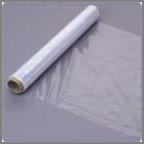Will Edible Coatings Soon Replace Plastic, Cardboard and Glass Packaging on Your Foods?
by www.SixWise.com
Most food at the supermarket is packaged using vacuum packing,
nitrogen sweeping and aluminum foil to keep food fresh inside
the familiar plastic and cardboard packages, but soon this
may all change.
|

Edible coatings could one day add flavors, extra vitamins
and food-poisoning protection to everyday foods.
|
Researchers are developing edible coatings that, they say,
could help reduce packaging materials, keep foods fresh longer
and make them look more attractive. The coatings are either
flexible and see-through, similar to the thin strips now sold
as breath fresheners, or clear and glossy films.
The idea is that the coatings, which are made from things
like whey protein isolate (WPI), mesquite gum and starch,
keep oxygen, water and oils where they belong, extending shelf-life
and preventing rancidity.
Anti-Microbial, Flavor-Enhancing Packages?
Currently, edible coatings are used on fruits like apples,
but one day researchers hope to use the films on a wide array
of foods, including those high in polysaturated fatty acids,
making them highly perishable (nuts, meat, salmon, etc.),
and those that are very fragile, like breakfast cereal.
Aside from keeping food fresh and protected, the coatings
also hold the possibility of containing antimicrobians that
could kill food-borne pathogens, or even add to a food's flavor,
such as an apple coating that would form a glaze on a ham
when it was cooked. One day, food coatings may even contain
extra nutrients like vitamin E or calcium to enhance a food's
nutritional value.
|
Does a Lot of Your Food
Come in Packages?

Most food sold in packages is processed, and not the
best thing to center your diet around -- even if the
package claims the food is healthy. If you want to know
how healthy of an eater you really are, you can take
this quiz now and find out:
How
Healthy are
Your Eating Habits?
|
Another interesting application? Edible sealed pouches that
contain a measured amount of ingredient such as flour that
could be thrown directly into a mixer, eliminating the need
to measure while baking.
Problems With Traditional Food Packaging
The move toward edible packaging has stemmed largely from
the demand for healthier, more environmentally friendly foods.
Current packaging practices use plasticizers and other synthetic
chemical compounds that are not always biodegradable -- or
entirely safe.
Butylated hydroxyanisole (BHA) and butylated hydroxytoluene
(BHT), for instance, which are used in food packaging to keep
fats and oils from going rancid, have been found by some studies
to cause cancer in rats.
Some food packaging also contains pesticides and other additives,
which can be transferred to your food. In fact, substances
transferred to food via packaging belong to the category of
"incidental additives" that do not have to be listed
on food
nutrition labels.
Traditional packaging isn't going to disappear anytime soon,
though. Edible coatings are still in the developmental stages,
poised to make a major impact in the future of food packaging.
Recommended Reading
12
Dangerous Food Additives: The Dirty Dozen Food Additives You
Really Need to be Aware Of
How
Many Insect Parts and Rodent Hairs are Allowed in Your Food?
Sources
Science
Daily September 6, 2006
FoodProductionDaily.com
Organic
Consumers Association